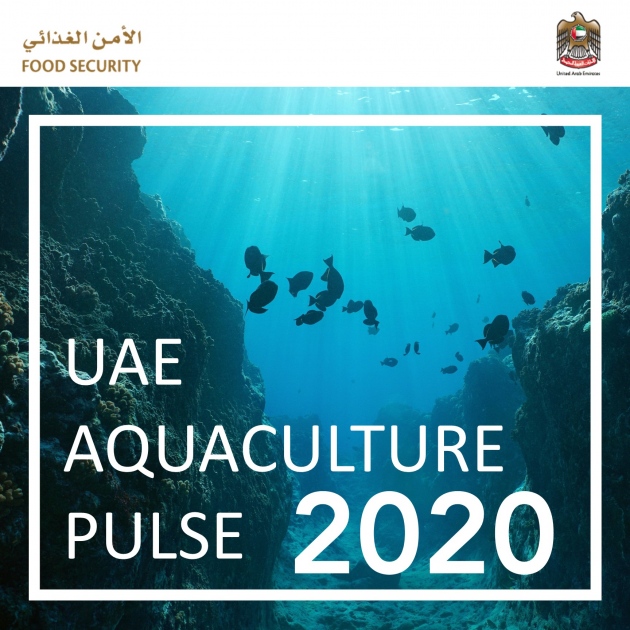
Minister of State for Food Security Launches UAE Aquaculture Pulse 2020 Guideline
“Aquaculture is a core component of the UAE’s National Food Security Strategy,” asserted Her Excellency Mariam Almheiri, Minister of State for Food Security, while launching the UAE Aquaculture Pulse 2020 – a document set to serve as a reference point, outlining and evaluating investment opportunities in the local aquaculture sector.
H.E. Almheiri launched the new project during a virtual meeting organised by the Food Security Office jointly with the United Nations’ Food and Agriculture Organisation (FAO) on Wednesday, June 24, 2020, to discuss ‘Supporting Sustainable and Innovative Aquaculture in the UAE’. The UAE Aquaculture Pulse 2020 studies consumption patterns in local and international markets, analysing production quality and size as well as prices and availability to support future investments in aquaculture projects in the UAE.
“The aquaculture sector offers promising opportunities to increase local food production,” H.E. said. “There are significant economic benefits to capitalise on as investments expand in this vital industry, not least of which is enhancing the UAE’s marine resources, ensuring their sustainability, and supporting efforts to providing sufficient, healthy, and safe food for everyone who lives in the UAE.”
“The UAE’s wise leadership prioritises the issue of food security and supports efforts to embrace technology and increase local production and address all of the challenges we face here in the UAE, among them being water scarcity,” H.E. explained. “The aquaculture sector promises to be an important source of high value protein as our population steadily grows, given that the UAE currently imports 70% of its fish annually. It is a good use of our water resources (mainly marine water) and aligns with national aspirations to achieve sustainability in all areas.”
“The UAE has what it takes to become a regional hub for hi-tech aquaculture, having already established several leading facilities, such as the Sheikh Khalifa Marine Research Centre which is currently under expansion” H.E. Mariam Almheiri noted. “The government has worked to facilitate investments in the sector, in partnership with various local and international entities. The newly launched Aquaculture Pulse 2020 supports investors to attract investment opportunities in the field. The document is set to be periodically updated to reflect the changes in the industry.”
Her Excellency stressed that it is expected that the aquaculture sector will witness more unprecedented growth during the coming years, and will be subject to special measures to enhance its productivity, in addition to that the sector will witness the launch of more innovative government initiatives to increase the attractiveness of foreign investment.
UAE Aquaculture Pulse 2020
The UAE Aquaculture Pulse 2020 sheds light on the state of the sector in the UAE and underlines the promising opportunities it presents. The document serves as a reference for those interested in aquaculture and fish hatcheries all around the country.
Fish hatcheries are a prominent topic of the new document, which lists the hatcheries available around the country that produce fish fingerlings (juvenile fish) of various types. The UAE is home to hatcheries that exist within fish farms, as well as the larger specialised hatcheries that produce approximately 35 million fingerlings. The Sheikh Khalifa Centre for Marine Research in Umm Al Quwain is a leading facility in this regard.
The document showcases the larger fish farms currently in operation in the UAE, which account for over 90% of the UAE’s current aquaculture production. These include the Al Jarf Fish Farm, which produces 1,000 tons of fish and shrimp, while Fish Farm Ltd. boasts an annual production capacity of 3,000 tons. Meanwhile, Emirates Fish Farms produces 120 tons of fish per year and owns hatcheries, which, in turn, produce 2 million fish fingerlings annually.
The document also highlights the potential of fish markets and their ability to offer local products in all emirates. It cites the waterfront market in Dubai, the Jubail market in Sharjah, and the fish market in Abu Dhabi port as prominent examples.
Supply and Demand for Fish Products
The UAE Aquaculture Pulse 2020 explores the demand-supply dynamic for fish products in the UAE as per current estimates. It identifies the species most in-demand for consumers, calculating their average price in various fish markets in the country.
The document identifies 11 species of fish, namely Cobia, Orange Spotted Grouper, White Spotted Rabbit Fish, Spangled Emperor, Grey Mullet, Goldline Seabream, Narrow-Barred Spanish, Mackerel, Tuna, Black Banded Trevally, Orange Spotted Trevally, and White Shrimp.



























